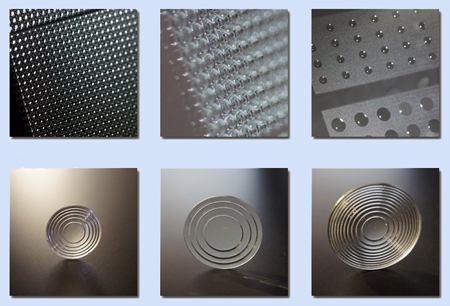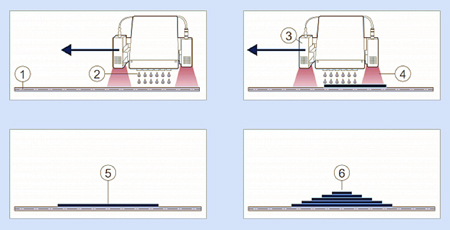Printable LED optics wins innovation prize 04 Oct 2012 Frost&Sullivan recognizes Luxexcel for"pioneering"manufacturing approach
 Luxexcel's technology provides the system integrator with flexibility.Market analyst company Frost&Sullivan has presented Luxexcel Group,Goes,Netherlands,with the 2012 European Frost&Sullivan Enabling Technology Award for its Printoptical Technology.Luxexcel's manufacturing process addresses the key challenges to large-scale application of LEDs in general lighting.
Luxexcel's technology provides the system integrator with flexibility.Market analyst company Frost&Sullivan has presented Luxexcel Group,Goes,Netherlands,with the 2012 European Frost&Sullivan Enabling Technology Award for its Printoptical Technology.Luxexcel's manufacturing process addresses the key challenges to large-scale application of LEDs in general lighting.
Currently,the majority of the LED chips are designed to deliver maximum light output.Consequently changing LED chips usually means changing secondary optics designs,which can mean that stock is wasted.Furthermore,injection molding-the conventional technology employed for manufacturing LED optics-is a time-consuming and expensive process,which can delay the development and introduction of new LED lighting devices.
Frost&Sullivan research analyst Shyam Krishnan commented,"Although LED for lighting applications is quite promising,the lengthy and expensive manufacturing processes and lack of industry standard have been the major challenges faced by system integrators in developing secondary optics needed for most LED lighting fixtures or luminaires."
"Luxexcel's innovative Printoptical technology prints optics directly from CAD files,reducing the manufacturing time and making the process simpler and less expensive by eliminating the need for expensive tools,molds or dies."Customers provide CAD files of the designs,which are directly printed in optics using a proprietary form of 3D printing.
One-step process
This approach removes the need for molds,intermediate steps,and post-processing.Furthermore,the Printoptical manufacturing process can print one optic or 10,000 copies.The reduction in the time taken to manufacture the optics,minimizes time-to-market and helps the manufacturer to better cater to customer demands.
Consequently,Luxexcel's technology provides the system integrator with the flexibility to manufacture the desired volume,preventing wastage of the manufactured product.The system integrator also has the advantage of changing the LED chip manufacturer,depending upon the market trends,as there is no need for stocking optics.In addition,variations of an optic design for an existing fixture can easily,quickly and economically be made to serve custom lighting opportunities.
In addition,the smoothness achievable in mold-making through subtractive machining is inherently afflicted by tool marks and abrasions and can never match the perfect smoothness formed by surface tension using the Printoptical process.The lack of flexibility in designing variety of textures and colours is another disadvantage of traditional injection molding.
Luxexcel marketing manager Marco de Visser told optics.org,"Currently we process all of our customers'orders in house,whether it is a single prototype or larger orders in volume.Since we started production in 2009,we have targeted the growing LED lighting sector,so typical customers are lighting developers,optical systems designers and LED manufacturers.Our selling point besides product quality,is that Luxexcels'Printoptical process means just one step from CAD file to the desired product."
Enabling new products
"The outstanding benefits Printoptical offers is expected to obliterate the hesitancy LED system manufacturers have been showing in introducing newer products with different optic designs,"noted Krishnan."Using Luxexcel's technology,customers can manufacture optics such as Fresnel lenses as well as free-form lenses,prisms,micro-structures,and optical laminates,and complex designs with complete color graphics and textured surfaces,bringing LED out of its niche bracket for wider applications."
While LED lighting is the initial target market for Luxexcel's Printoptical technology,the company has also started to focus on advertising graphics,digital arts,and manufacturing needs of various industries.Printoptical is based on the wide-format industrial inkjet printing equipment,which enables printing of very complex designs that is simply not possible a??or is overly expensive a??with other manufacturing processes.
The company also plans to establish relationships with solar and construction industry manufacturers.Optical structures printed by using Printoptical technology have the potential to enhance the conversion of solar energy into electrical light,so the efficiency of the photovoltaic cell can be improved.
"Compared to its competitors,Luxexcel's technology provides its customers with quality LED products at a lower overall cost and reduced time-to-market,"added Krishnan."These factors have enabled LUXeXceL to position itself as a potential major LED optics manufacturer for the majority of LED system integrators in the industry."

Award-winning:Luxexcel's Printoptical process.The Printoptical process
On a transparent substrate such as a polycarbonate,drops of clear UV-cureable polymer are jetted via the inkjet principal.The drop-sizes vary according to graphic design.The UV is cured via strong UV-lamps causing extreme polymerization resulting that the polymer will set straight away.This process is repeated for every layer or pixel resulting in transparent geometrical shapes,optical-and magnifying structures.
Each year,Frost&Sullivan presents the Enabling Technology Award to a company in the advanced optics market that has developed a pioneering technology that not only enhances current products but also enables the development of newer products and applications.The award recognizes the high market acceptance potential of the recipient's technology.
About the Author Matthew Peach is a contributing editor to optics.org